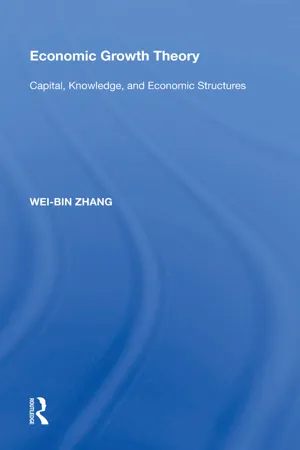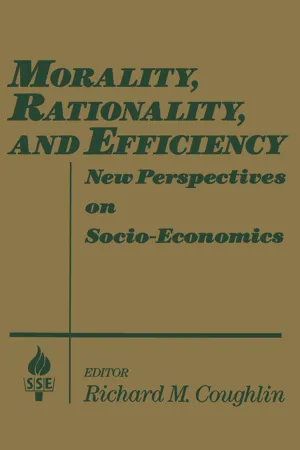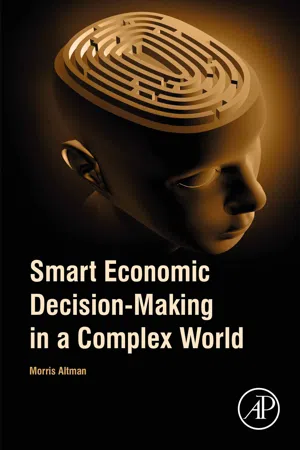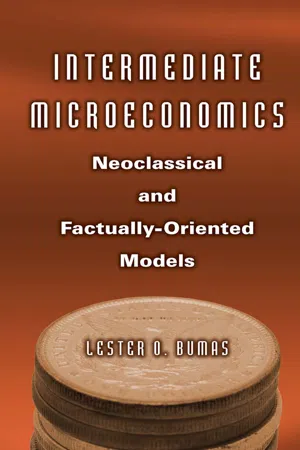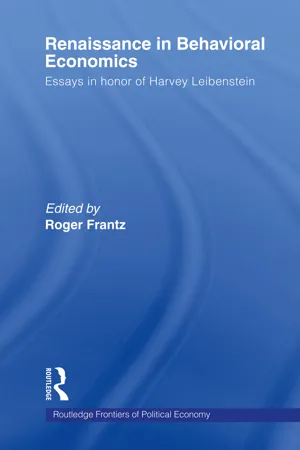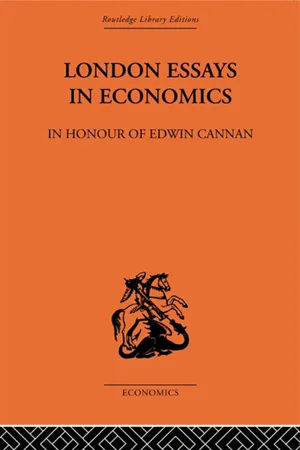Economics
Efficiency Wages
Efficiency wages refer to higher-than-market wages paid by firms to increase worker productivity and reduce turnover. This concept suggests that paying workers more than the equilibrium wage can lead to improved performance, reduced shirking, and lower labor turnover, ultimately benefiting the firm. This approach is based on the idea that higher wages can motivate employees to work more efficiently.
Written by Perlego with AI-assistance
Related key terms
Related key terms
1 of 4
Related key terms
1 of 3
9 Key excerpts on "Efficiency Wages"
- eBook - ePub
Economic Growth Theory
Capital, Knowledge, and Economic Stuctures
- Wei-Bin Zhang(Author)
- 2018(Publication Date)
- Routledge(Publisher)
The wage that maximizes effort per dollar of wages is the efficiency wage. In efficiency-wage theories, it is assumed that there is a cost as well as a benefit to firms of paying lower wages. It is possible to harm a firm if it pays lower wages. Firms would not reduce wages because higher wages may raise the productivity of labor. Firms try to create idiosyncratic value for their workers in their jobs, so that the threat to terminate deters misconduct such as shirking. For instance, an increase in a worker' income can cause him to be better nourished and thus enables him to work more effectively. A higher wage (than the market-average wage) can increase workers' efforts because the jobs have 'additional values' to them and they don't want to lose the jobs. Workers secure jobs through working hard. A high wage can also build loyalty among workers. High loyalty increases the firm's labor productivity - for instances, costs due to strikes can be avoided by high wages. As high wages can also attract workers with high reservation wages, applicant pool is expanded by high wages. We may explain behavior of firms from the cost perspective. Raising wage rate raises labor cost by making firms pay more to workers, but reduces labor cost per unit of output by making workers more efficient. As shown in Figure 7.4b, initially a percent increase in real wage rate raises e by more than 1 percent, so labor cost declines. Firms continue raising w until it reaches the equilibrium value w *, which occurs at the point where raising w by 1 percent raises efficiency by exactly 1 percent, thus leaving labor cost per unit of efficiency unchanged. Firms will not raise real wage rate any further, since this would raise wage payment more than it would boost efficiency. From how this efficiency wage is determined, we see that firms have no incentive to cut wages when there is unemployment in labor market. The efficiency wage theory helps explain wage rigidity - eBook - ePub
Morality, Rationality and Efficiency
New Perspectives on Socio-economics
- Richard M. Coughlin(Author)
- 2016(Publication Date)
- Routledge(Publisher)
3 Markets, Competition, and EfficiencyPassage contains an image
6 The Socio-Economics of Labor ProductivityPETERB.DOERINGERInstitutional economists have frequently observed systematic differences among firms in their wage strategies (Dunlop, 1957; Doeringer and Piore, 1985; Hildebrand, 1963). Some firms deliberately adopt policies of paying high wages, others pay the "going or average" rate, and still others offer below-average compensation (Reynolds, 1951). More recent quantitative studies of inter-establishment wage structures confirm this finding and there is evidence that these pay differences persist over long periods of time (Groshen, 1988a, 1988b).One interpretation of this finding is that apparent differences in pay by firm or by industry simply relfect differences in worker productivity or in the nonpecuniary aspects of jobs; a second is that pay is not uniquely a function of labor force quality so that earnings can also depend on the firm or industry in which a worker is employed (Katz, 1986). The latter interpretation has led to a body of "efficiency wage" theory postulating a causal relationship between above-market pay premiums and higher profits (Groshen, 1988a, 1988b).Most of the economics literature explaining how pay is related to labor efficiency sees high wages as a means of overcoming market failures that result in principal-agent problems and other sources of allocative inefficiency. There are several different versions of efficiency wage theories—selection and matching, turnover, and monitoring/motivation—each positing a different set of stylized facts about the workplace (Katz, 1986; Weiss, 1990).Selection and matching theories postulate the existence of certain hard-to-measure abilities that are particularly productive under some technologies and work settings. Where such abilities are required, employers seek efficient ways of recruiting such workers. Under the assumption that the reservation wages of workers with these "superproductive" qualities are higher than those of other workers, high wage employment offers can lower recruitment costs by expanding the pool of qualified applicants and improving the efficiency of worker-job matching (Weiss, 1980,1990; Katz, 1986; Weitzman, 1989). - Morris Altman(Author)
- 2020(Publication Date)
- Academic Press(Publisher)
Fig. 7.3 Labour demand, marginal product of labour and Efficiency Wages.The contemporary efficiency wage literature, especially that related to the work of Akerlof, ties the notion of Efficiency Wages to the world of developed economies wherein wages affect the level of effort input through their motivational effects on workers. In Leibenstein’s narrative the latter step is missing, at least explicitly, as he draws a direct and tight link between wages to caloric and related nutritional intake to effort input. In the contemporary narrative effort input is increased with higher wages as higher wages are a proxy for fairness and the like. But no detailed discussion is provided with regards to how wages per se fit into the overall industrial relations bundle. At best, the wage rate is viewed as a proxy for all that which motivates workers (Altman, 2002 ). But the bottom line in this literature, as in the Leibenstein narrative, is that there is a unique net revenue or profit maximizing ‘efficiency wage’, whatever its psychological or sociological determinants.It is also important to note an important distinction between Leibenstein’s solution to the involuntary unemployment, which amounts to featherbedding, and one proposed in the contemporary efficiency wage literature such as is articulated in Akerlof, Dickens, and Perry (2000) . Leibenstein argues that firms must hire more workers than would be consistent with profit maximizing so as to prevent real wages from being bid downwards through the excess supply of labour. Therefore, workers would be employed whose marginal product is less than their real wage. If employers fail to do so—and failure is assured absent a resolution to fundamental coordination problems—real wages and net revenue would fall. In the contemporary efficiency wage literature, no coordination problem presents itself so that the efficiency wage is stable as would be a certain amount of involuntary unemployment. But Akerlof et al. (2000)- eBook - ePub
Labour Market and Fiscal Policy Adjustments to Shocks
The Role and Implications for Price and Financial Stability in South Africa
- Nombulelo Gumata, Eliphas Ndou(Authors)
- 2017(Publication Date)
- Palgrave Macmillan(Publisher)
efficiency wage hypotheses we ask: Does labour productivity growth increase due to a positive minimum wage shock? Does price stability matter for positive minimum wage growth shock effects on labour productivity?(8.1)What does the efficiency wage theory suggest? Equation (8.1 ) shows the production function in Froyen (2002 ), which depends on capital, K , and the number of workers, L , the real wage, w , and the effort per worker or worker productivity, e . Labour input is measured in efficiency units. The number of efficiency units of labour input equals the number of workers (L ) multiplied by the index of efficiency e (w ). The labour input in this model impacts output in two ways. First, output increases when more units of labour are hired. Second, output increases when the efficiency of the existing labour force improves, and efficiency depends positively on real wages.This is the first link showing a positive relationship between wage efficiency and output. The assumption is that wages above the average will increase incentives to work and lead to better economic performance through lower absenteeism and better adaptation of workers.1 The efficiency wage effect postulates that higher wages may spur workers to work harder, thus improving productivity.2How useful is the efficiency wage theory? It is useful because, first, within the efficiency wage models , the wage rate plays a dual role as (1) to allocate jobs, and (2) it affects the behaviour of workers by affecting physical productivity, work effort and morale, and determines the quality of the labour hiring pool or the probability of acceptance of a firm’s employment offer. Second, it offers insights into the channels of the transmission of the efficiency wage hypothesis to increased productivity. These channels work via (1) the reduction in employee turnover or ‘churn’, (2) reductions in absenteeism - eBook - ePub
Intermediate Microeconomics
Neoclassical and Factually-oriented Models
- Lester O. Bumas(Author)
- 2015(Publication Date)
- Routledge(Publisher)
There are two reasons for the association of the efficiency wage with unemployment. First, it allows an employer to attain a given rate of output with fewer employees. Second, assuming unemployment exists, the efficiency wage is not reduced to equilibrate the market because that would lower both productivity and profits. Thus, the maintenance of unemployment.Fair questions regarding the efficiency wage model are: If the efficiency wage is more profitable than the market wage why is the market wage not increased to the efficiency level? Is the failure to pay the efficiency wage irrational?The Insider-Outsider Model
The insiders in this model are the employed. The outsiders are the unemployed. The insiders have more bargaining power than the outsiders, power which allows them to obtain a higher-than-market wage. The power of the insiders is in the area of transaction costs. The termination of an insider tends to involve severance and morale costs. The employment of an outsider tends to require spending on search and on-the-job training. The greater these transaction costs are, the greater is the ability of insiders to attain above-market wages. This creates an incentive for insiders to increase transaction costs. If workers are represented by a union, for example, an increase in severance pay would do just that as would an arbitration or work stoppage challenging the termination of an insider.What about unemployed workers willing to work for lower pay than insiders? To successfully underbid insiders, outsiders would have to accept pay lower than insiders by at least transaction costs. And, if they did, insiders might take steps costly to the employer. Senior workers are frequently used to informally train new hires in the most efficient ways of accomplishing work tasks. That informal help could be curtailed. And production is frequently accomplished by teams, and aspects of teamwork could be reduced. As a consequence of the transaction and other costs, insiders are hypothesized as being able to obtain and maintain a wage higher than market clearing. - eBook - ePub
- Roger Frantz(Author)
- 2007(Publication Date)
- Routledge(Publisher)
The contemporary efficiency wage literature, especially that related to the work of Akerlof, ties the notion of Efficiency Wages to the world of developed economies wherein wages affect the level of effort input through their motivational effects on workers. In Leibenstein’s narrative the latter step is missing, at least explicitly, as he draws a direct and tight link between wages and caloric intake and effort input. In the contemporary narrative, effort input is increased with higher wages as higher wages are a proxy for fairness and the like. But no detailed discussion is provided with regards to how wages per se fit into the overall industrial relations bundle. At best, the wage rate is viewed as a proxy for all that motivates workers (Altman, 2002). But the bottom line in this literature, as in the Leibenstein narrative, is that there is a unique net revenue or profit-maximizing “efficiency wage,” whatever its psychological or sociological determinants.It is also important to note an important distinction between Leibenstein’s solution to involuntary unemployment, which amounts to featherbedding, and one proposed in the contemporary efficiency wage literature. such as articulated in Akerlof et al. (2000). Leibenstein argues that firms must hire more workers than would be consistent with profit maximizing so as to prevent real wages from being bid downwards through the excess supply of labor. Therefore, workers would be employed whose marginal product is less than their real wage. If employers failed to do so – and failure is assured absent a resolution to fundamental coordination problems – then real wages and net revenue would fall. In the contemporary efficiency wage literature, no coordination problem presents itself, so the efficiency wage is stable – as would be a certain amount of involuntary unemployment. However, Akerlof et al. - eBook - ePub
Modern Labor Economics
Theory and Public Policy (International Student Edition)
- Ronald G. Ehrenberg, Robert S. Smith(Authors)
- 2017(Publication Date)
- Routledge(Publisher)
Journal of Labor Economics 15 (April 1997): 318–337.34 It should be clear that the efficiency wage refers to all forms of compensation, not just cash wages. Lawrence Katz, “Efficiency Wage Theories: A Partial Evaluation,” in NBER Macroeconomics Annual, 1986 , ed. Stanley Fischer (Cambridge, MA: MIT Press, 1986); Joseph E. Stiglitz, “The Causes and Consequences of the Dependence of Quality on Price,” Journal of Economic Literature 25 (March 1987): 1–48; and Kevin M. Murphy and Robert H. Topel, “Efficiency Wages Reconsidered: Theory and Evidence,” in Advances in Theory and Measurement of Unemployment , eds. Yoram Weiss and Gideon Fishelson (London: Macmillan, 1990), offer detailed analyses of efficiency-wage theories.35 Janet Yellen, “Efficiency Wage Models of Unemployment,” American Economic Review 74 (May 1984): 200–208; and Andrew Weiss, Efficiency Wages: Models of Unemployment, Layoffs, and Wage Dispersion (Princeton, NJ: Princeton University Press, 1990).36 Richard Thaler, “Anomalies: Interindustry Wage Differentials,” Journal of Economic Perspectives 3 (Spring 1989): 181–193; Surendra Gera and Gilles Grenier, “Interindustry Wage Differentials and Efficiency Wages: Some Canadian Evidence,” Canadian Journal of Economics 27 (February 1994): 81–100; and Paul Chen and Per-Anders Edin, “Efficiency Wages and Industry Wage Differentials: A Comparison across Methods of Pay,” Review of Economics and Statistics 84 (November 2002): 617–631.37 Alan B. Krueger, “Ownership, Agency and Wages: An Examination of Franchising in the Fast Food Industry,” Quarterly Journal of Economics 106 (February 1991): 75–101; Erica L. Groshen and Alan B. Krueger, “The Structure of Supervision and Pay in Hospitals,” Industrial and Labor Relations Review 43 (February 1990): 134S–146S; Carl M. Campbell III, “Do Firms Pay Efficiency Wages? Evidence with Data at the Firm Level,” Journal of Labor Economics 11 (July 1993): 442–470; Bradley T. Ewing and James E. Payne, “The Trade-Off between Supervision and Wages: Evidence of Efficiency Wages from the NLSY,” Southern Economic Journal 66 (October 1999): 424–432; and Bjorn Bartling, Ernst Fehr, and Klaus M. Schmidt, “Screening, Competition, and Job Design: Economic Origins of Good Jobs,” American Economic Review - eBook - ePub
- Morris Altman(Author)
- 2020(Publication Date)
- Routledge(Publisher)
5The Economics of Exogenous Increases in Wage Rates in a Behavioral/X-Efficiency Model of the Firm
Introduction
Standard neoclassical theory predicts that higher real wage rates result in less employment and a lower rate of employment growth than would otherwise exist with lower real wage rates.1 Thus exogenous interventions in the labor market that serve to increase real wage rates, such as effective minimum wage legislation and effective unionization, are said to have deleterious effects on the economy. Underlying these dominant theoretical propositions and their concomitant policy prescriptions, which decry minimum wage legislation and the existence of trade unions, is the assumption that given a prevailing factor input mix, higher wage rates do not affect labor productivity.2 But for this to hold true, on average , those firms affected by minimum wage legislation and unions must be maximizing output per unit of labor input, or as Harvey Leibenstein puts it, firms must be operating x-efficiently. As noted, Leibenstein’s general x-efficiency theory suggests, however, that as a rule, labor productivity in the firm is not maximized; therefore, the firm generally tends to produce x-inefficiently.3The argument presented in this chapter holds that to the extent that x-inefficiency exists, higher wages “shock” a firm into producing more x-efficiently and, in effect, cause an upward shift in the firm’s marginal product of labor curve. In contrast, lower wage rates serve to shelter a firm from competitive pressures, allowing the low-wage firm to generate the same rate of profit or unit costs as a high-wage firm does but at a lower level of x-efficiency. Under these specified conditions, higher wage rates that result from minimum wage legislation, unionization, or any other variation of nonmarket-induced increases in wage rates need not cause a reduction in either employment or employment growth. Theoretically, it is feasible that such wage shocks to the economic system will generate even more employment and higher rates of employment growth than would be possible in a relatively low-wage world. Therefore, introducing the possibility of x-inefficiency in one’s modeling of the firm allows one to raise the possibility that policy prescriptions flowing from standard theory are inappropriate and misleading and can, in and of themselves, have harmful effects on the economy. - Hugh Dalton, T. E. Gregory(Authors)
- 2013(Publication Date)
- Routledge(Publisher)
“Wages” have in fact ceased to be a clear cut economic classification, and are now a payment for functions so diverse in nature, and subject to conditions of supply so dissimilar that statements as to movements of general wages tell us very little. The question arises as to what it is that wages are paid for. As we have seen it is difficult to discover a product for which payment is made, especially when we find that at times the “product” exists only in the estimation of the employer, subsequent events proving him to have miscalculated his market. When we discuss “high wages” or “low wages” we appear to be thinking of the value of something, presumably a unit of work which is being valued. But we cannot define it. Are we thinking of payment for an hour’s application of energy? If so, how are we to tell whether the price paid for it is high or low if, for example, efficiency or working hours change? Do we mean earnings per worker? If so, how long a period are we to take into account? We realize that it is useless to take wage rates per hour as our measure, especially when thinking of wages as a basis of distribution, but why should we stop at a year?There seems no doubt that any approach to the theory of wages must start from a recognition of the part played by wage payments in the theory of production. We must realize that we are dealing with something subject to the ordinary laws of valuation. Attempts have been made by wage regulators during the last thirty years to act as if this were not the case, but the underlying economic principles have ultimately shown that there are very real limits to what can be done.168
Index pages curate the most relevant extracts from our library of academic textbooks. They’ve been created using an in-house natural language model (NLM), each adding context and meaning to key research topics.
Explore more topic indexes
Explore more topic indexes
1 of 6
Explore more topic indexes
1 of 4
